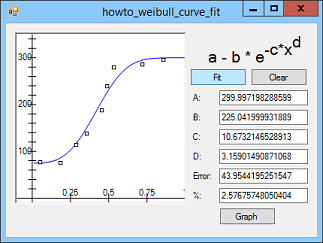![[C# Helper]](../banner260x75.png)
|
|
 |
![[Beginning Database Design Solutions, Second Edition]](db2_79x100.png)

Title: Find a least squares Weibull curve fit for a set of points in C#

Not long ago, a client wanted to fit a set of data points to a Weibull curve of the form:

The earlier example Find an exponential least squares fit for a set of points in C# explains how to find a least squares fit for exponential data. This example uses a similar technique with the following differences:
The following code shows the function.
// Return the function for x, a, b, and c. public static double F(double x, double a, double b, double c, double d) { return a - b * Math.Exp(-c * Math.Pow(x, d)); } The following method calculates the error squared for a set of points and the coefficients a, b, c, and d.
// Return the sum of errors squared for // the given points and parameters. public static double ErrorSquared(List<PointF> pts, double a, double b, double c, double d) { double total_error = 0; for (int i = 0; i < pts.Count; i++) { double new_error = pts[i].Y - F(pts[i].X, a, b, c, d); if (total_error > 1E+15) break; total_error += new_error * new_error; } return total_error; } This method calculates the function's values at each point's X coordinate, subtracts that from the data point's X value, and squares the differences. It adds up the results for all of the points. Like the previous example, this program uses the error function's gradient to follow the surface (in this case a 4D surface) towards a minimum. To do that it uses the error function's partial derivatives. For example, the following method calculates the function's partial derivative with respect to a.
// dE/da private static double dEda(List<PointF> pts, double a, double b, double c, double d) { double total = 0; for (int i = 0; i < pts.Count; i++) { total += 2 * (F(pts[i].X, a, b, c, d) - pts[i].Y) * dFda(pts[i].X, a, b, c, d); } return total; } The program uses the partial derivatives to find the error function's gradient and then follows the opposite of the gradient to a minimum. See the earlier example for more details about how this technique works. For more information on classical Weibull functions, see:
Download the example to experiment with it and to see additional details. |
![[Beginning Software Engineering, Second Edition]](book_sw_eng2_79x100.png)
![[Essential Algorithms, Second Edition]](book_algs2e_79x100.png)
![[The Modern C# Challenge]](book_csharp_challenge_80x100.jpg)
![[WPF 3d, Three-Dimensional Graphics with WPF and C#]](book_wpf3d_80x100.png)
![[The C# Helper Top 100]](book_top100_80x100.png)
![[Interview Puzzles Dissected]](book_interview_puzzles_80x100.png)
![[C# 24-Hour Trainer]](book_csharp24hr_2e_79x100.jpg)
![[C# 5.0 Programmer's Reference]](book_csharp_prog_ref_80x100.png)
![[MCSD Certification Toolkit (Exam 70-483): Programming in C#]](book_c_cert_80x100.jpg)